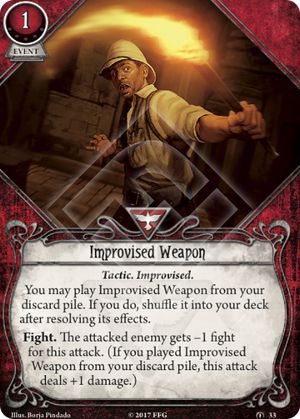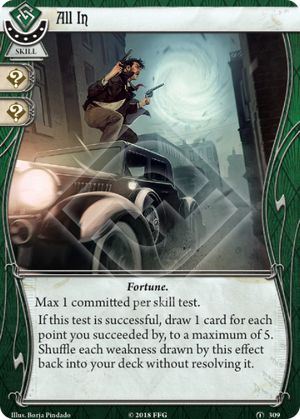
Improvised Weapon - the ultimate back-up weapon?
Having played around with Improvised Weapon my conclusion is it fits the slot of a versatile back-up weapon.
When building for an investigator that can take Improvised Weapon it is never going to compete for the main weapon slot. There is still the need however for an alternative means of combat to hand in case you haven't drawn the main weapon, or you happen to be out of ammo/charges, or just want save ammo for the last swing. If combat is a focus, just including 4 weapons (two main, two backup) in a deck is not necessarily ideal but the temptation can be to include more weapons, which of course can reduce the flexibility of the deck.
In considering this back-up slot, something that may not be immediately obvious at first pass is the recursion potential of Improvised Weapon. After use from the discard it returns to your deck, which depending on the class will almost always be getting smaller. This means that although it only takes up one to two slots in deck construction, Improvised Weapon is effectively going to count as more copies of itself each time it is shuffled back into the deck. Even if this happens just once or twice a game your effective deck size is increasing by that amount, or to see it slightly differently, you have the potential to have more than two copies of Improvised Weapon in your deck without altering your deck size restriction.
This feature has pros and cons. By making your deck bigger the more you use Improvised Weapon, the less likely you are to draw another card you might need. However if you are using it you probably want to be seeing combat options sooner rather than later. Plus if you don't use it, well it just sits in your hand or discard until you do.
The second feature that makes Improvised Weapon shine is being an event that results in a fight action. This means no attacks of opportunity whenever it is used, no playing to the table that allows loss from asset-hate or competition with hand slots. It even resists deck milling by the mythos (which in turn makes it more effective!). In terms of straight damage it is very close to a knife that is discarded on the second action, but one that is fast, can be played from a discard pile and you can have more than two in your deck.
A brief mention also should be mentioned with regards to the -1 enemy fight value. As with shroud reduction verses investigation boost, reducing an enemy fight value is slightly better than boosting fight, even though the benefit is felt more with lower level fight tests. At present this is the only fight option that does this directly, Anatomical Diagrams being the only player card at present which does reduce fight but unfortunately without the fight action included.
The other points and considerations from previous reviews above are still very valid. While Improvised Weapon is a versatile back up or filler weapon, it isn't going to take down any enemies of more than 3 health and 3 fight easily on its own. In the most favourable situation assuming one Improvised Weapon in hand and one in the discard, it could dish out 5 damage for 3 resource and 3 action cost with 3 successful combat checks. Not perfect but it could save the day...
That said, Investigators that can take this and want to fight often may want rethink ignoring this card, especially early in a campaign. It can be useful for that odd ping of 1-2 damage in high combat investigators to save ammo and even in low combat investigators to give them at least something to fight back with. There will be better options later on, especially when classes are able to tutor for their main weapons, but even in late in a campaign, and depending on the scenario, being played from the discard can be clutch, while being filtered back into the deck ensures more readily available combat options are not far away.
In summary, don't ignore the effectiveness, recursion and resilience of this card as a combat option when everything else is against you. It works well equally with or without Dark Horse and especially well with discard options such as Cornered or, "Ashcan" Pete and Wendy Adams abilities. While the optimum play may be on a 1 fight enemy with 2 health when played from the discard pile, this card has a lot more going for it, even without other cards to support it.
Considering the Survivor faction, in my opinion this card is a flavour and faction home run; and one that is competes soundly for the title of the ultimate back-up weapon!
(Yes Survival Knife is ace, but no true survivor is going to want to take attacks on the chin regularly!)




